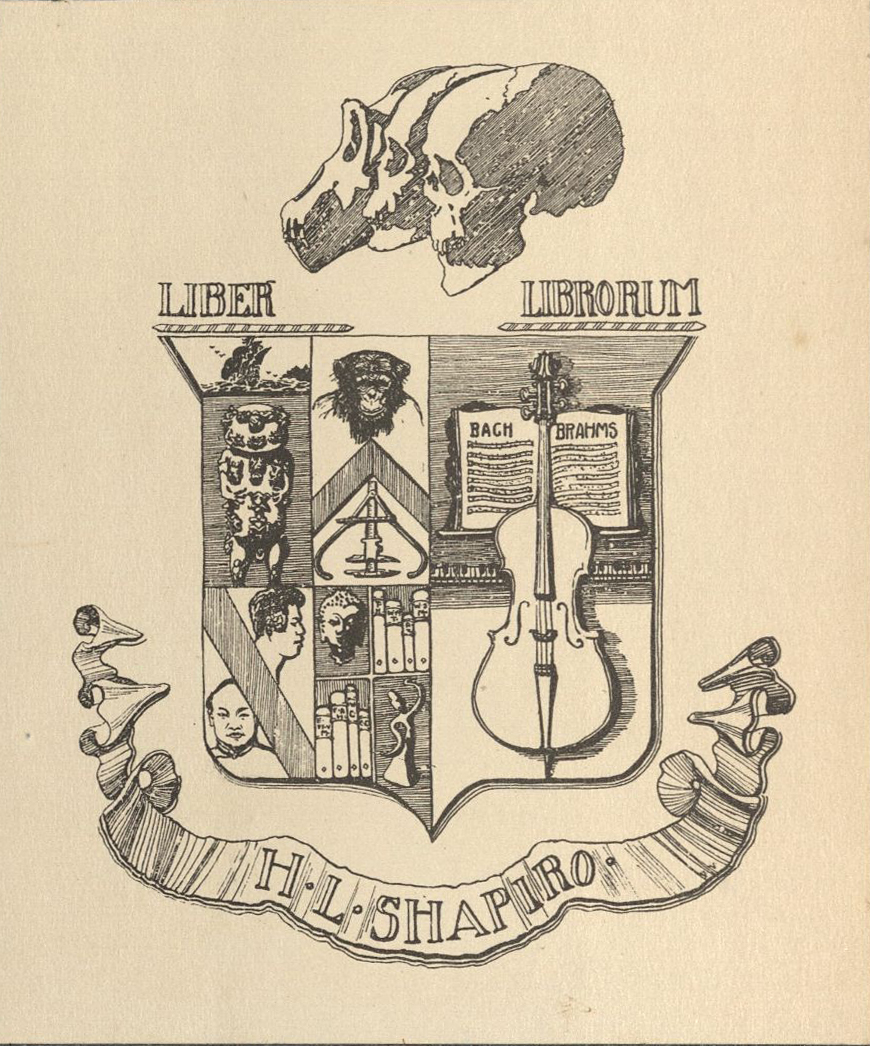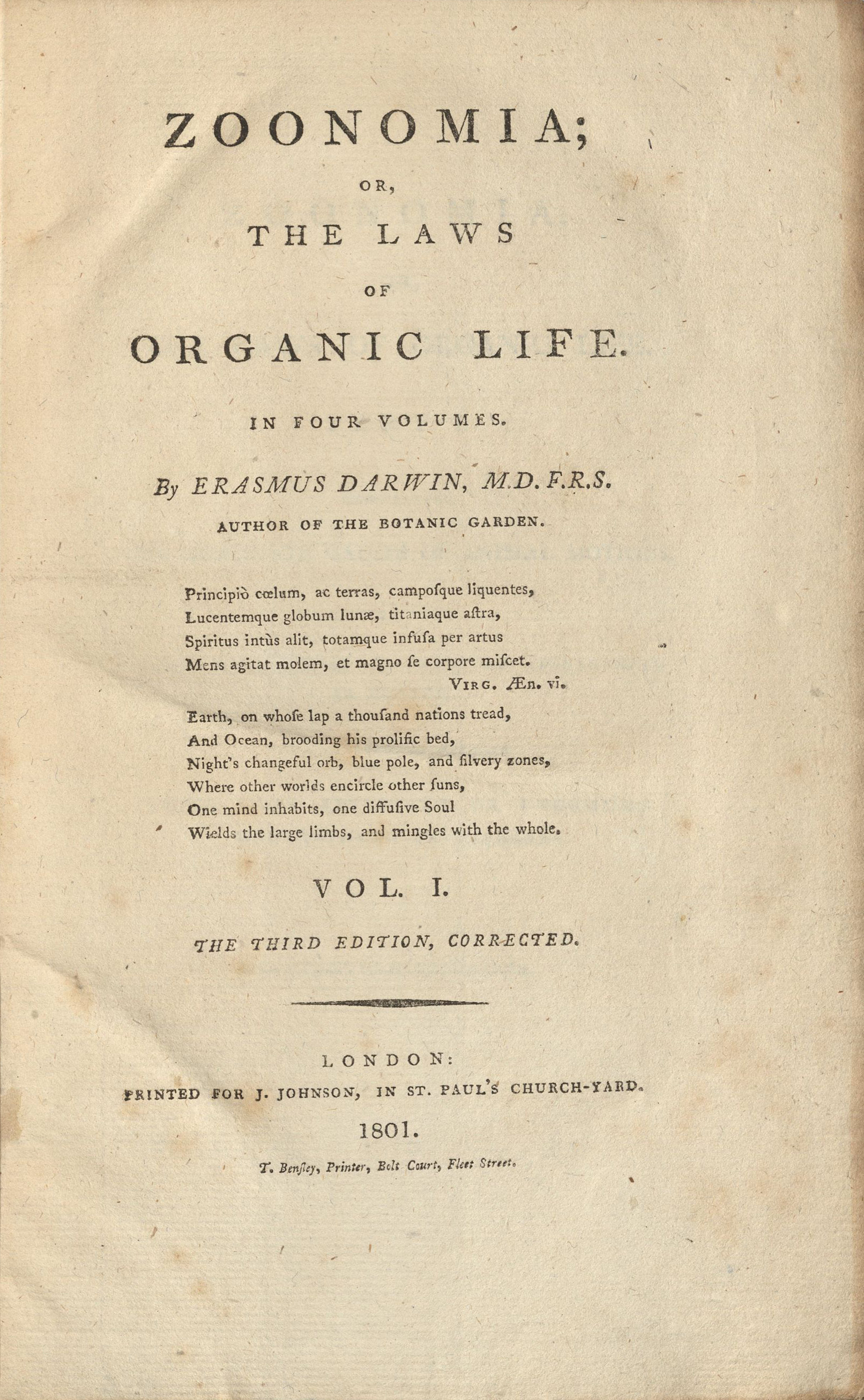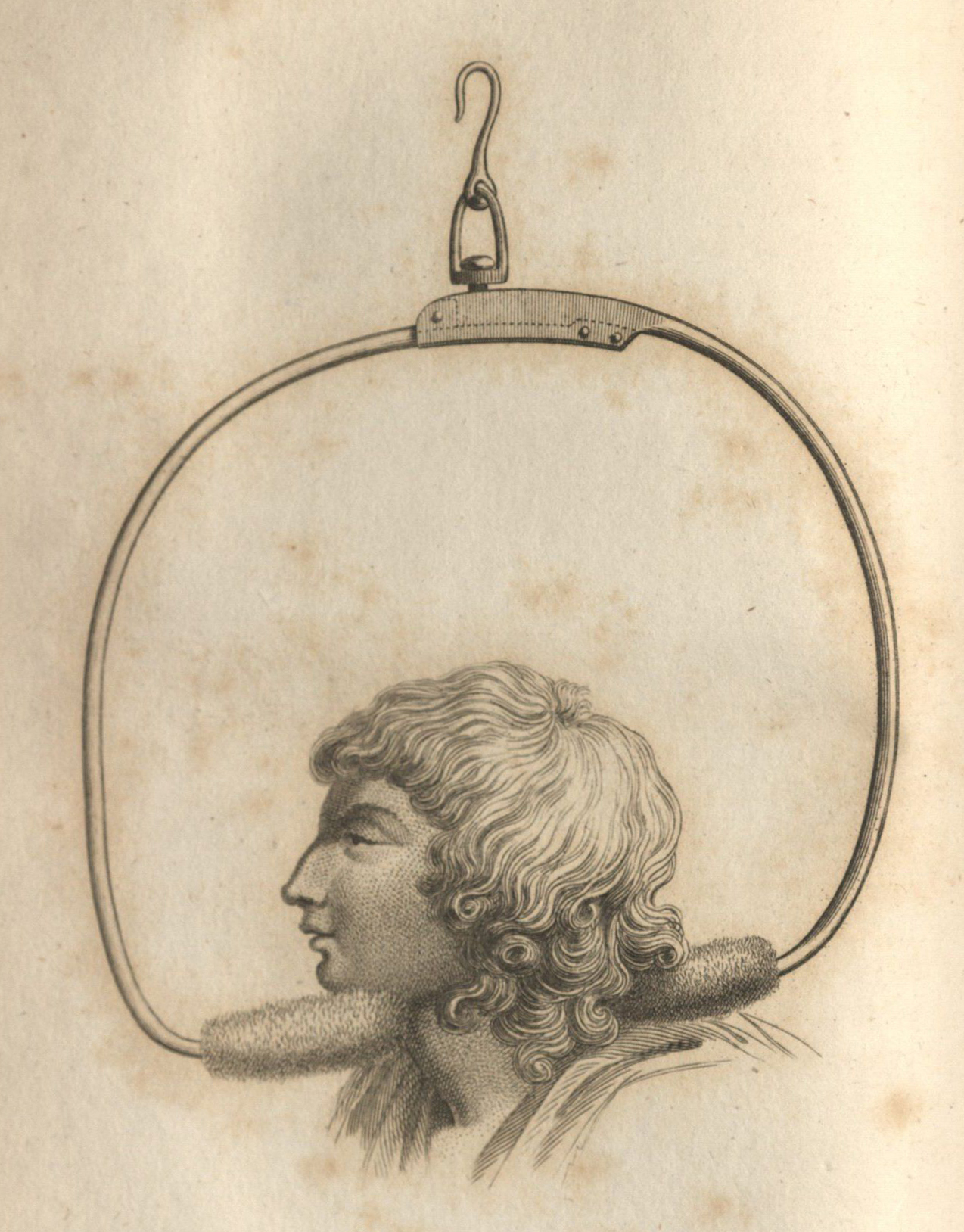Difference between revisions of "Zoonomia or The Laws of Organic Life"
Mvanwicklin (talk | contribs) m |
m |
||
| (26 intermediate revisions by 3 users not shown) | |||
| Line 2: | Line 2: | ||
===by Erasmus Darwin=== | ===by Erasmus Darwin=== | ||
__NOTOC__ | __NOTOC__ | ||
| − | {{ | + | {{BookPageInfoBox |
| + | |imagename=DarwinZoonomia1801v1Title.jpg | ||
| + | |link=https://wm.primo.exlibrisgroup.com/permalink/01COWM_INST/g9pr7p/alma991034018348903196 | ||
|shorttitle=Zoonomia or The Laws of Organic Life | |shorttitle=Zoonomia or The Laws of Organic Life | ||
| − | + | |author=[[:Category: Erasmus Darwin|Erasmus Darwin]] | |
| − | + | |edition=Third, corr. | |
| − | |author=[[:Category:Erasmus Darwin|Erasmus Darwin]] | + | |lang=[[:Category: English|English]] |
| − | | | + | |publoc=[[:Category: London|London]] |
| − | | | + | |publisher=J. Johnson |
| − | |publoc= | + | |year=1801 |
| − | |publisher= | + | |set=4 |
| − | |year= | + | |desc=[[:Category:Octavos|8vo]] (22 cm.) |
| − | | | + | |shelf=N-4 |
| − | | | + | }}Erasmus Darwin (1731-1802), was a doctor, poet, inventor, and botanist, who also provided insights in physics, chemistry, geology, meteorology, and biology.<ref>[http://www.erasmusdarwin.org/learning/erasmus-darwin/ "Erasmus Darwin"] in ''Erasmus Darwin House''. accessed November 8, 2018.</ref> He was a leader in the intellectual communities, such as the Lunar Society, which contributed to many areas including industrialization.<ref>"Erasmus Darwin."; [http://www.ucmp.berkeley.edu/history/Edarwin.html "Erasmus Darwin (1731-1802)"] in ''UCMP: UC Museum of Palentology'', accessed November 8, 2018.</ref> Some of his intellectual peers included James Watt, Matthew Boulton, Joseph Priestly, and Josiah Wedgwood.<ref>Ibid.</ref> One of his greater achievements was his work in biology, which included his theories on natural selection and evolution.<ref>Maureen McNeil, "[https://doi.org/10.1093/ref:odnb/7177 Darwin, Erasmus (1731–1802)]" in ''Oxford Dictionary of National Biography'', accessed May 3, 2023.</ref> Over a 25 year period, Erasmus came up with one of the first coherent theories of evolution, a full 70 years before his grandson, Charles Darwin, which he published in ''Zoonomia or the Laws of Organic Life'' in 1794.<ref>"Erasmus Darwin."</ref> |
| − | | | + | |
| − | | | + | {{BookPageBookplate |
| − | | | + | |imagename=DarwinZoonomia1801v1Bookplate.jpg |
| + | |display=left | ||
| + | |caption=Bookplate of [[wikipedia: Harry_L._Shapiro|H. L. Shapiro]], front pastedown, volume one. | ||
}} | }} | ||
| − | + | ''Zoonomia or the Laws of Organic Life'' comprises forty sections describing different motions, anatomy, and diseases.<ref>Erasmus Darwin, ''Zoonomia or the Laws of Organic Life'' (London: J. Hohnson, 1794), v-vi.</ref> In this work, Erasmus Darwin classified animal life into classes, orders, genera, and species through comparing them with each other.<ref>Darwin, ''Zoonomia or the Laws of Organic Life'', 1.</ref> Through these classifications, Erasmus was hoping to discover more about the theory of diseases.<ref>Ibid.</ref> Erasmus wanted to provide better patient care through the betterment of the theory of diseases.<ref>Darwin, ''Zoonomia or the Laws of Organic Life'', 1-3.</ref> At the time this book was published, it was well-received, with one reviewer comparing Erasmus Darwin's contributions to medicine with Sir Isaac Newton's contributions to natural philosophy.<ref>"Erasmus Darwin."</ref> | |
| + | |||
==Evidence for Inclusion in Wythe's Library== | ==Evidence for Inclusion in Wythe's Library== | ||
| + | Listed on the [[Jefferson Inventory]] as "[Darwin's] Zoonomia. 3.v. 8vo." and given by [[Thomas Jefferson]] to his son-in-law [[Thomas Mann Randolph]]. Brown's Bibliography<ref>Bennie Brown, "The Library of George Wythe of Williamsburg and Richmond," (unpublished manuscript, May, 2012) Microsoft Word file. Earlier edition available at: https://digitalarchive.wm.edu/handle/10288/13433</ref> lists the 1st American edition, an octavo three-volume set published in Philadelphia in 1797, based on the copy Thomas Jefferson sold to the Library of Congress in 1815.<ref>E. Millicent Sowerby, ''Catalogue of the Library of Thomas Jefferson''(Washington, D.C.: The Library of Congress, 1952-1959), 1:487, [[https://babel.hathitrust.org/cgi/pt?id=mdp.39015033648091&view=1up&seq=438 no. 896]].</ref>. [http://www.librarything.com/profile/GeorgeWythe George Wythe's Library]<ref>''LibraryThing'', s.v. [http://www.librarything.com/profile/GeorgeWythe "Member: George Wythe"], accessed on May 2, 2023.</ref> on LibraryThing indicates "Precise edition unknown." Wythe's copy was most likely the 1st American edition which was published in two parts by two different publishers. T. & J. Swords in New York published Part One (volume one) in 1796. Philadelphia's T. Dobson produced Part Two in two volumes in 1797 (volumes two and three). A difficult item to find, the Wolf Law Library purchased an available copy of the four volume 3rd. ed. corr., an octavo set published in London and the last edition published in Darwin's lifetime. | ||
| + | |||
| + | ==Description of the Wolf Law Library's copy== | ||
| + | Bound in modern half green calf with marbled paper covered boards. Spines feature five single raised bands outlined with gilt and blind rules, second and third panels lettered in gilt, top edges in blue. Fore and bottom edge untrimmed. Volume one includes the bookplate of H. L. Shapiro on the front pastedown. Purchased with the [[:Category:George Wythe Boswell-Caracci Room Acquisition Fund|George Wythe Boswell-Caracci Room Acquisition Fund]]. | ||
| + | |||
| + | Images of the library's copy of this book are [https://www.flickr.com/photos/wolflawlibrary/albums/72177720308587540 available on Flickr.] View the record for this book in [https://wm.primo.exlibrisgroup.com/permalink/01COWM_INST/g9pr7p/alma991034018348903196 William & Mary's online catalog.] | ||
| + | [[File:DarwinZoonomia1801v3IllustrationOppP141Detail.jpg|left|thumb|250px|Illustration of steel bow for straightening the spine, volume three, page 141]] | ||
==See also== | ==See also== | ||
| Line 30: | Line 42: | ||
[[Category:Erasmus Darwin]] | [[Category:Erasmus Darwin]] | ||
| + | [[Category:George Wythe Collection at William & Mary's Wolf Law Library]] | ||
[[Category:Science and Medicine]] | [[Category:Science and Medicine]] | ||
[[Category:Thomas Mann Randolph's Books]] | [[Category:Thomas Mann Randolph's Books]] | ||
[[Category:Titles in Wythe's Library]] | [[Category:Titles in Wythe's Library]] | ||
| + | [[Category:George Wythe Boswell-Caracci Room Acquisition Fund]] | ||
[[Category:Octavos]] | [[Category:Octavos]] | ||
Latest revision as of 10:56, 20 March 2025
by Erasmus Darwin
| Zoonomia or The Laws of Organic Life | |
|
Title page from Zoonomia or The Laws of Organic Life, George Wythe Collection, Wolf Law Library, College of William & Mary. | |
| Author | Erasmus Darwin |
| Published | London: J. Johnson |
| Date | 1801 |
| Edition | Third, corr. |
| Language | English |
| Volumes | 4 volume set |
| Desc. | 8vo (22 cm.) |
| Location | Shelf N-4 |
Erasmus Darwin (1731-1802), was a doctor, poet, inventor, and botanist, who also provided insights in physics, chemistry, geology, meteorology, and biology.[1] He was a leader in the intellectual communities, such as the Lunar Society, which contributed to many areas including industrialization.[2] Some of his intellectual peers included James Watt, Matthew Boulton, Joseph Priestly, and Josiah Wedgwood.[3] One of his greater achievements was his work in biology, which included his theories on natural selection and evolution.[4] Over a 25 year period, Erasmus came up with one of the first coherent theories of evolution, a full 70 years before his grandson, Charles Darwin, which he published in Zoonomia or the Laws of Organic Life in 1794.[5]

Zoonomia or the Laws of Organic Life comprises forty sections describing different motions, anatomy, and diseases.[6] In this work, Erasmus Darwin classified animal life into classes, orders, genera, and species through comparing them with each other.[7] Through these classifications, Erasmus was hoping to discover more about the theory of diseases.[8] Erasmus wanted to provide better patient care through the betterment of the theory of diseases.[9] At the time this book was published, it was well-received, with one reviewer comparing Erasmus Darwin's contributions to medicine with Sir Isaac Newton's contributions to natural philosophy.[10]
Evidence for Inclusion in Wythe's Library
Listed on the Jefferson Inventory as "[Darwin's] Zoonomia. 3.v. 8vo." and given by Thomas Jefferson to his son-in-law Thomas Mann Randolph. Brown's Bibliography[11] lists the 1st American edition, an octavo three-volume set published in Philadelphia in 1797, based on the copy Thomas Jefferson sold to the Library of Congress in 1815.[12]. George Wythe's Library[13] on LibraryThing indicates "Precise edition unknown." Wythe's copy was most likely the 1st American edition which was published in two parts by two different publishers. T. & J. Swords in New York published Part One (volume one) in 1796. Philadelphia's T. Dobson produced Part Two in two volumes in 1797 (volumes two and three). A difficult item to find, the Wolf Law Library purchased an available copy of the four volume 3rd. ed. corr., an octavo set published in London and the last edition published in Darwin's lifetime.
Description of the Wolf Law Library's copy
Bound in modern half green calf with marbled paper covered boards. Spines feature five single raised bands outlined with gilt and blind rules, second and third panels lettered in gilt, top edges in blue. Fore and bottom edge untrimmed. Volume one includes the bookplate of H. L. Shapiro on the front pastedown. Purchased with the George Wythe Boswell-Caracci Room Acquisition Fund.
Images of the library's copy of this book are available on Flickr. View the record for this book in William & Mary's online catalog.
See also
References
- ↑ "Erasmus Darwin" in Erasmus Darwin House. accessed November 8, 2018.
- ↑ "Erasmus Darwin."; "Erasmus Darwin (1731-1802)" in UCMP: UC Museum of Palentology, accessed November 8, 2018.
- ↑ Ibid.
- ↑ Maureen McNeil, "Darwin, Erasmus (1731–1802)" in Oxford Dictionary of National Biography, accessed May 3, 2023.
- ↑ "Erasmus Darwin."
- ↑ Erasmus Darwin, Zoonomia or the Laws of Organic Life (London: J. Hohnson, 1794), v-vi.
- ↑ Darwin, Zoonomia or the Laws of Organic Life, 1.
- ↑ Ibid.
- ↑ Darwin, Zoonomia or the Laws of Organic Life, 1-3.
- ↑ "Erasmus Darwin."
- ↑ Bennie Brown, "The Library of George Wythe of Williamsburg and Richmond," (unpublished manuscript, May, 2012) Microsoft Word file. Earlier edition available at: https://digitalarchive.wm.edu/handle/10288/13433
- ↑ E. Millicent Sowerby, Catalogue of the Library of Thomas Jefferson(Washington, D.C.: The Library of Congress, 1952-1959), 1:487, [no. 896].
- ↑ LibraryThing, s.v. "Member: George Wythe", accessed on May 2, 2023.

